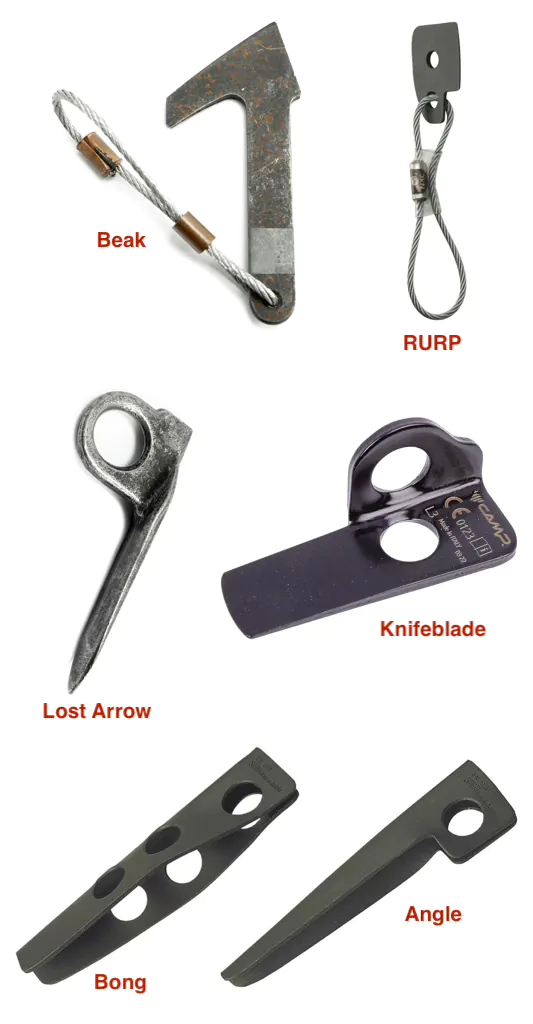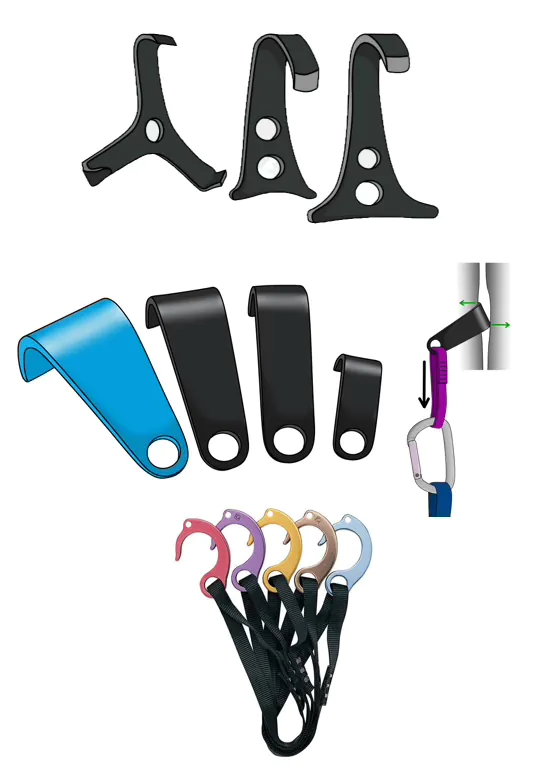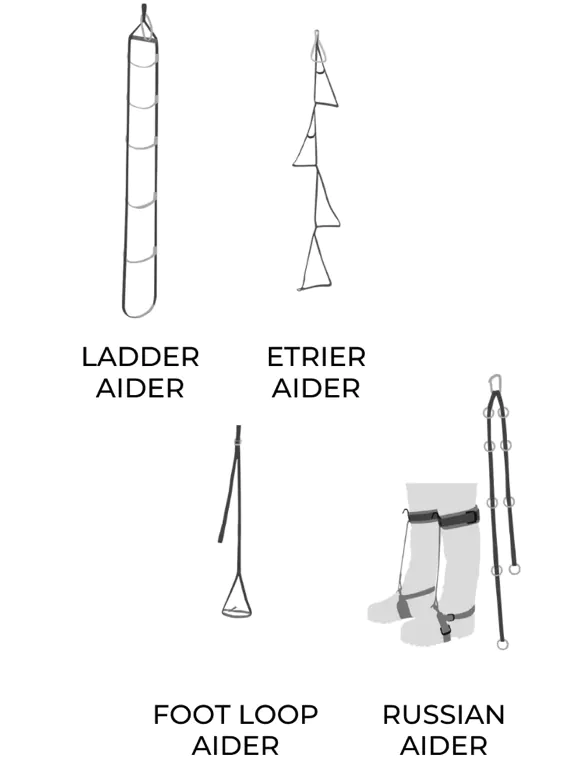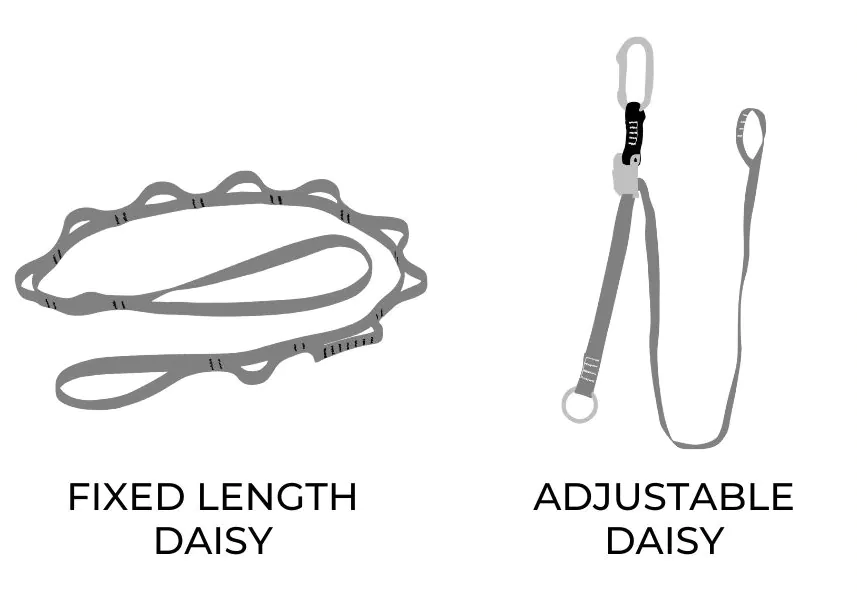Aid Climbing Gear
Aid climbing is a form of rock climbing that uses mechanical devices and equipment for assisting in moving upwards - in contrast from free climbing, where equipment is used only for protection, but not to assist in upward movement. Aid climbing can involve hammering-in permanent pitons and bolts, into which the aiders are clipped, and also can be 'clean', where hammering is avoided, and only removable placements are used.
Modern aid climbing uses most of the protection equipment used in trad climbing (e.g. nuts, hexcentrics, tricams, cams), as is it needed for clean aid climbing. But there is a number of items of equipment that are uniquely used in aid climbing: pitons, hooks, aiders and daisy chains.

Pitons
A piton is a metal spike that is hammered into a crack or seam in the rock, acting as an anchor for protecting the climber from falling or to assist progress in aid climbing. Pitons are equipped with an eye hole or a ring to which a carabiner is attached.
Different pitons are manufactured to fit a wide range of cracks. From small to large, the most common types are:
RURP (Realized Ultimate Reality Piton) - a tiny piton the size of a post stamp used in thin, shallow seams. Not a strong piece, mainly used for aid climbing, or as pro on extreme free routes.
Beak (a.k.a. Birdbeak, Pecker, Tomahawk) - a hooking thin crack piton with the ability to be placed without a hammer.
Knifeblade (a.k.a. bugaboo) - a thin straight piton, for thin, deep cracks.
Lost Arrow (a.k.a. wedge piton) - a hot-forged, tapered piton for medium-sized cracks.
Angle - a piton made of steel sheet bent into a 'U', 'V', or 'Z' shape. It works well for larger cracks, where the steel deforms elastically as the piton is placed.
Bong - largest pitons are angles made from sheet aluminum called a bong, named for the sound they produce while being hammered into place. Mostly replaced by cams and nuts that perform better and doesn't damage the rock.

Hooks
Hooks work best on flakes or incut edges of solid rock. Feel the edge of rock with your fingertips to find a depression in a rock for a secure placement.
Skyhooks come in many different sizes and shapes. The 3 most common types are Bat / Talon (small), Cliffhanger (medium), and Grappling (large). Having two of each is recommended for consecutive moves with the same sized hook.
Cam hooks come in four common sizes, and greatly reduce the need to hammer a piton. They fit into small cracks, and work by simply camming against the sides of a crack under bodyweight. Cam hooks can be placed in vertical, diagonal or horizontal cracks, or even inverted in roofs.
Fifi hooks are question-mark-shaped steel or alloy tools, usually small, with a large hole at the bottom for connecting to the gear and a smaller hole at the top for a retrieval cord. Its basic function is to quickly hook into gear and take one’s weight. It offers very little strength, and requires a care when used.

Aiders
Aiders are devices made of webbing, that are clipped to ascenders, protection or bolts to create artificial steps, thus ‘aiding’ climbers up a route. There are four categories of aiders, based on their overall shape and construction. Depending on the type of climbing, each aider type has advantages and features which are designed to overcome certain obstacles while aiding.
- Ladders have two parallel sides joined by horizontal webbing, forming box-shaped steps. Best for Big wall, Aid climbing.
- Etriers have triangular steps that alternate on opposite sides of webbing. Best for Alpine, Mixed aid, Free climbing.
- Foot Loops are an adjustable length single triangular step that hangs from a cord or webbing. Best for Route setting, as a Backup, Crevasse rescue kits.
- Russian Aiders use stirrups with metal hooks on the legs to walk up metal rings sewn into webbing, which are separate and clipped to protection or gear. Best for Aid climbing in overhanging, awkward positions.

Daisy chains
Daisy chains are sewn piece of webbing which are used for connecting temporarily to a piece of protection. Their main function is to hold a climber’s weight while aid climbing, while still being attached to the rope or main personal anchor.
Daisy chains are not tested and certified as climbing gear, and should not be used as personal anchors.
Fixed length daisy chains are used for capturing progression and reaching higher placements by clipping on progressively higher pockets.
Adjustable daisy chains capture progress and hold the body weight from a single connection point, which can be tightened or loosened as the person moves up or down in their aiders.
